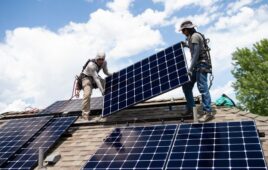According to a review by the SUN DAY Campaign of data just released by the Federal Energy Regulatory Commission (FERC), renewable energy sources dominated new U.S. electrical generating capacity additions in the first eight months of 2020. Combined, they accounted for 63.3% — or 10,445 MW — of the 16,499 MW of new utility-scale capacity added during the first two-thirds of this year.
FERC’s latest monthly “Energy Infrastructure Update” report (with data through August 31, 2020) also reveals that natural gas accounted for 36.5% (6,029 MW) of the total, with very small contributions by coal (20 MW) and “other” sources (5 MW) providing the balance. There have been no new capacity additions by oil, nuclear power, or geothermal energy since the beginning of the year.
Moreover, all of the 2,781 MW of new generating capacity added during June, July and August was provided by solar (1,448 MW), wind (1,309 MW), and hydropower (24 MW).
Renewable energy sources now account for 23.2% of the nation’s total available installed generating capacity and continue to expand their lead over coal (20.1%). The generating capacity of just wind and solar is now at 13.3% of the nation’s total — not including distributed (residential rooftop) solar.
For perspective, five years ago, FERC reported that installed renewable energy generating capacity was 17.4% of the nation’s total with wind at 5.9% (now 9.2%) and solar at 1.1% (now 4.1%). By comparison, in August 2015, coal’s share was 26.5% (now 20.1%), nuclear was 9.2% (now 8.7%), and oil was 3.9% (now 3.3%). Only natural gas has shown any growth among non-renewable sources, expanding modestly from a 42.8% share five years ago to 44.6% today.
In addition, FERC data suggest that renewables’ share of generating capacity is on track to increase significantly over the next three years (by August 2023). “High probability” generation capacity additions for wind, minus anticipated retirements, reflect a projected net increase of 27,761 MW while solar is foreseen growing by even more — 30,356 MW. By comparison, net growth for natural gas will be only 23,413 MW. Thus, wind and solar combined are forecast to provide more than twice as much new generating capacity as natural gas over the next three years.
While hydropower, geothermal, and biomass also are all projected to experience net growth (1,030 MW, 178 MW, and 116 MW respectively), the generating capacities of coal and oil are projected to plummet — by 23,881 MW and 5,019 MW respectively. In fact, FERC reports no new coal capacity in the pipeline over the next three years and just 4 MW of new oil-based capacity. Nuclear power is likewise forecast to drop sharply — by 4,630 MW.
In total, the mix of all renewables will add more than 59,400 MW of net new generating capacity to the nation’s total by August 2023 while the net new capacity from natural gas, coal, oil, and nuclear power combined will actually drop by over 10,100 MW .
If these numbers hold, over the next three years, renewable energy generating capacity should account for comfortably more than a quarter of the nation’s total available installed generating capacity — increasing from 23.2% today to 27.0% in three years. Meanwhile, coal’s share will drop to 17.4% (from 20.1% today), nuclear to 8.0% (from 8.7%), and oil to 2.8% (from 3.3%). Natural gas’ share will barely budge — increasing to 44.7%, compared to 44.6% now.
In fact, renewables’ share could be even higher. Over the past 18 months, FERC has been regularly increasing its renewable energy projections in the monthly “Infrastructure” reports. For example, eight months ago (in its December 2019 report), FERC forecast net growth over the next three years of 48,254 MW for renewable energy sources — 11,187 MW less than its latest projection.
“Renewable energy sources continue to displace fossil fuels and nuclear power, and the trend is accelerating,” noted Ken Bossong, Executive Director of the SUN DAY Campaign. “Depending on the results of the upcoming election, they are poised for explosive growth in the years ahead.”
News item from SUN DAY





“Renewable energy sources now account for 23.2% of the nation’s total available installed generating capacity and continue to expand their lead over coal (20.1%). The generating capacity of just wind and solar is now at 13.3% of the nation’s total — not including distributed (residential rooftop) solar.”
“not including distributed (residential rooftop) solar.” This last part is important to understand what it means ‘overall’. First the wholesale energy market right now is Centralized generation with dispatch over power corridors. Be it solar PV, CSP, wind or fueled generation anything sent over the grid from a centralized point loses about 15 to 25% of the power put on the grid in transformer losses. Solar PV generated where it will be used doesn’t have these inefficiencies and there is an (actual) savings by NOT having to put another generation asset online, usually fueled to make up for grid losses and grid load demands. The self consumption solar PV with energy storage system will come down in cost, as the solar PV and the battery storage becomes more energy dense, the cost of a system will come down as utility electricity rates continue to climb. It seems like places like Australia and Hawaii have set the bar at what point solar PV and ESS become an easy choice. Australia’s average electricity costs are around $0.25/kWh, Hawaii is real close. The grid will always be inefficient, but with Behind The Meter energy storage at every home one could run the grid more efficiently by NOT having to feed particular line constricted areas from two or three points to meet demand, but use the grid as is, more efficiently by allowing a more continuous energy flow and not necessarily have those ‘super off peak’ times of the late night and early morning as one could set up BTM to charge in off periods of the late night for the the next mornings wake up energy demand surge.